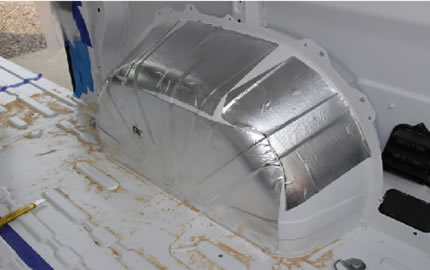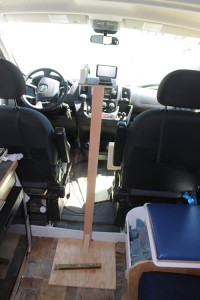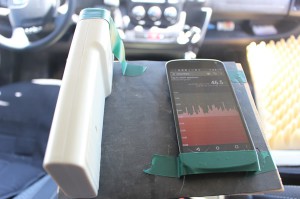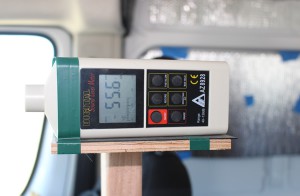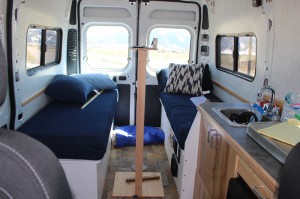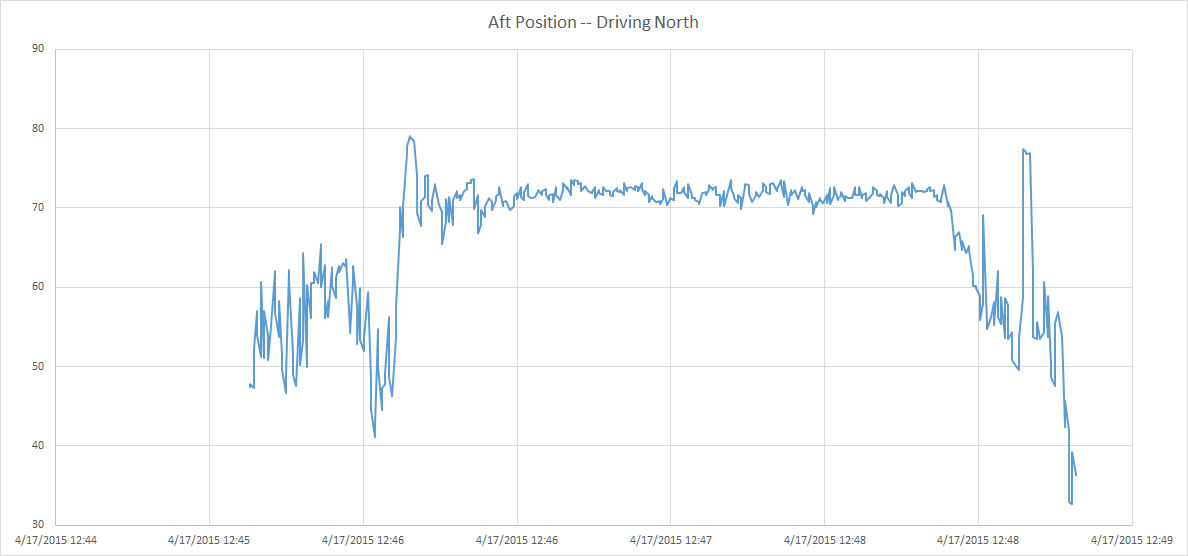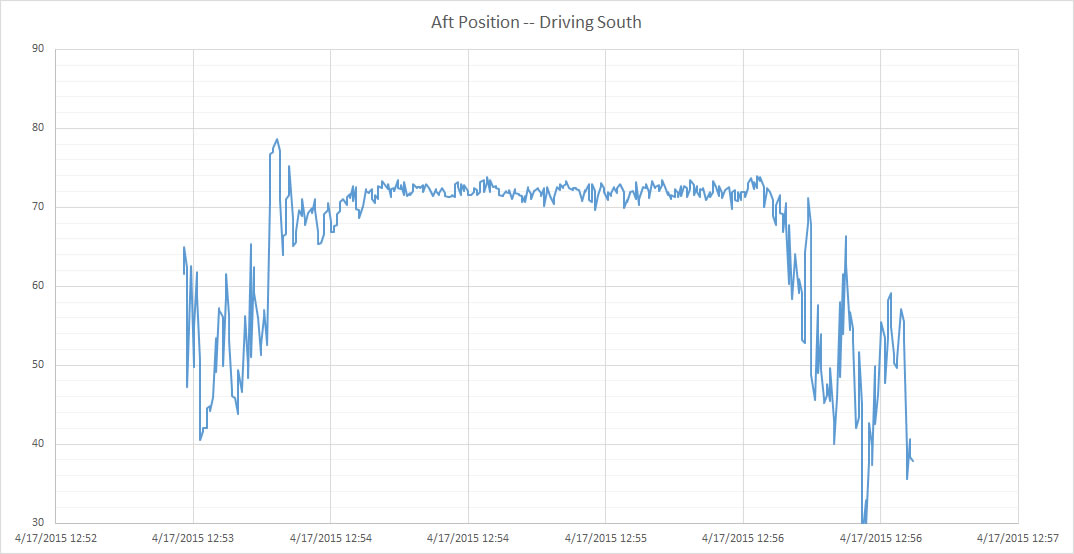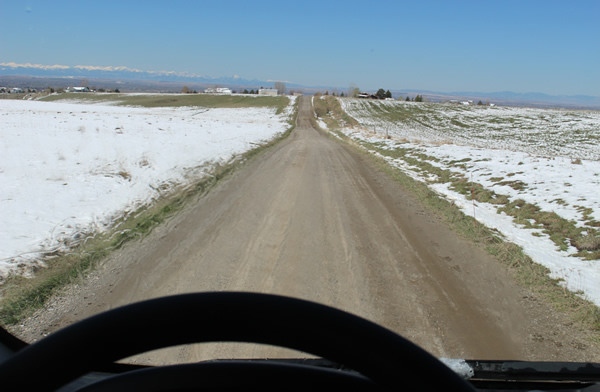A number of people are reporting on the conversion of their ProMaster vans to campers on the ProMaster Forum. Some people are installing quite a bit of noise treatment material to bring noise levels down, while some others are doing little or nothing in the way of noise treatment other than installing insulation and paneling.
This brings up the question of whether or not investing in noise treatment (beyond insulation and paneling) pays off, and how much noise reduction it provides, and which noise reduction techniques have the best bang for the the buck?
I posted a message on the PM Forum suggesting that those of us doing conversions take some before and after noise measurements to answer the questions above. I suggested a test procedure for taking the measurements so that we could get consistent results that could be compared to find out which noise treatments work and how well. There was a fair bit of interest in this, and it looks like we will get some measurements as people move along with their conversions.
While its too late on my conversion to get a “before conversion” noise measurement, I decided to take the “after” measurements, and this page reports the results and shows the test procedure and passes on some lessons learned with using the noise meters.
If you can do measurements on your van, that would be great — you can post the results on the ProMaster Forum or send them in to me (gary@BuildItSolar.com).
Go back to the main camper van conversion page…
Current Level of Noise Treatment
In our ProMaster conversion the only dedicated noise treatment are some patches of the adhesive noise damping material on the fender wells.
The walls and ceiling have about 3/4 inch of polyurethane spray foam.
The the sliding door or the back doors are just bare metal with no treatment.
The floor has rigid polyiso insulation board plus 1/4 inch plywood underlayment plus Vinyl flooring.
The walls are paneled with 1/4 inch plywood like material, and the ceiling is paneled with a hardboard like material.
Noise Measuring Procedure
This is the procedure I suggested in the post:
Before:
1- buy a cheap noise meter. I’ve got this one for $25 it appears to work quite well and gets lots of good reviews.2- Make a 4 ft high support for the noise meter that you can place on the floor of the van. This could just be a 4 ft long 2 by 4 screwed to a square of plywood to serve as the base — or anything that will support the noise meter 4 ft off the floor.
3- Pick a section of road that you want to use to do the noise measuring. Maybe a mile of “average” paved road that you can easily drive the van over with noise meter before and after the conversion.
Do the noise measurements:
1 – Before the conversion — mount the noise meter between the driver and passenger seats on the 4 ft high pedestal with the meter 2 ft back from dashboard. With an assistant to read the meter (or a video cam to record it) do the run on your standard road at 60 mph once in each direction. Note the weather, time of day, … anything that might influence the measurements.2 – Move the noise meter and pedestal to a position half way back in the cargo part of the van — e.g. half way between the back of the driver/pax seat and the rear door. Repeat the same two 60 mph runs on your standard road section.
After the conversion, repeat the same measurement runs as you did before the conversion. Even better, repeat the noise runs several times as you (say) finish the bare noise treatment, after floor, after paneling, etc. But, the main thing would be to get the bare van and the fully treated van.
The difference in noise levels between the two runs gives the noise reduction for the noise reduction your conversion achieves.
Post your noise readings and the noise reduction materials you used as well as the type of paneling, insulation, flooring…
I have zero experience doing noise measurements, so if you have a better idea or improvements to the procedure to suggest, please do.
After doing the tests, I think this could be simplified a bit — see section at end.
Measuring Noise
Based on the forum comments, I decided to try both the noise meter I bought and the noise meter apps that were available for my Nexus 4 Android phone. I tried 3 of the phone noise meter apps and used the one that gave the best agreement with the actual noise meter on side by side tests, which is Noise Meter 2.0 by JINASYS available as a free download at the Google PlayStore. It agrees pretty well with the actual noise meter whereas the other two downloads I tried had differences as much as 6 db. The Sound Meter Pro from Smart Tools had a means to calibrate the phone meter, and I tried this, but could not get a calibration that worked across a range of noise levels.
One nice feature of the Noise Meter 2.1 is that it will log the noise readings to a file which can then be opened in Excel for plotting (examples below).
It appears that the phone app noise meters are a bit doubtful and the errors vary from phone to phone as a function of the individual phone microphones and gain systems. Some of the noise apps have been calibrated to actual phones, so if you can find one that says its been calibrated to your phone that would be a good thing.
There are articles out there in which the accuracy of the smart phone noise meters has been tested against lab quality meters in a controlled environment. This is one of them: “So How Accurate Are These Smartphone Sound Measurement Apps?”, Kardous and Shaw. They looked at 130 Iphone apps and found only 3 apps were within +- 2 db of the actual values. They looked at 60 or so Android phones and these were worse than the Iphones — apparently the Iphone hardware is better suited to noise measurements than the typical Android hardware. Looking at their plot of their results, there is something like 20 db difference between the highest and lowest reading apps (and this is among the 10 apps they felt would do the best and actually tested)!
It seems that with this variation between phones, that absolute noise measurements made with phones meters in our vans don’t mean much — the variation from phone to phone is larger than the noise level differences due to different treatment levels that we are looking for. But, if the levels are measured before and after conversion with the same phone and over the same road etc., then the differences may still be meaningful, and may indicate how well each treatment is doing.
I think that measurements taken with the $25 noise meter are likely to be more useful. The meter claims an accuracy of +- 3 db, and presumably measurements taken with two of these meters will show more consistency than two different brands of smartphones.
In the end I placed my actual noise meter right next to my phone running Noise Meter 2.1 and got noise levels from both.
Setting Up
I built a 4 ft high pedestal from scraps of plywood and 2 by 3. I placed the 2 by 3 leg at the forward edge of the plywood so that I could position the meters right over the step in the floor that is just behind the seats.
The top of the pedestal is an about 6 by 6 inch scrap of plywood with a 45 mil layer of EPDM rubber over it to reduce transmission from pedestal to meters.
I just used electrical tape to hold the meters in place on the pedestal. A weight on the back of the plywood base keeps the pedestal from tipping forward.
The Test
The main test was done on Springhill Road north of Bozeman, MT. Its a pretty good asphalt road that was chip sealed several years ago.
Date: April 17, 2015 Starting about 12:10 PM
Temperature: about 55F
Wind: near calm
Clear skies.
ProMaster: radio off, windows closed, heating system fan off (this makes a difference — see below).
The Test
The main test was done on Springhill Road north of Bozeman, MT. Its a pretty good asphalt road that was chip sealed several years ago.
Date: April 17, 2015 Starting about 12:10 PM
Temperature: about 55F
Wind: near calm
Clear skies.
ProMaster: radio off, windows closed, heating system fan off (this makes a difference — see below).
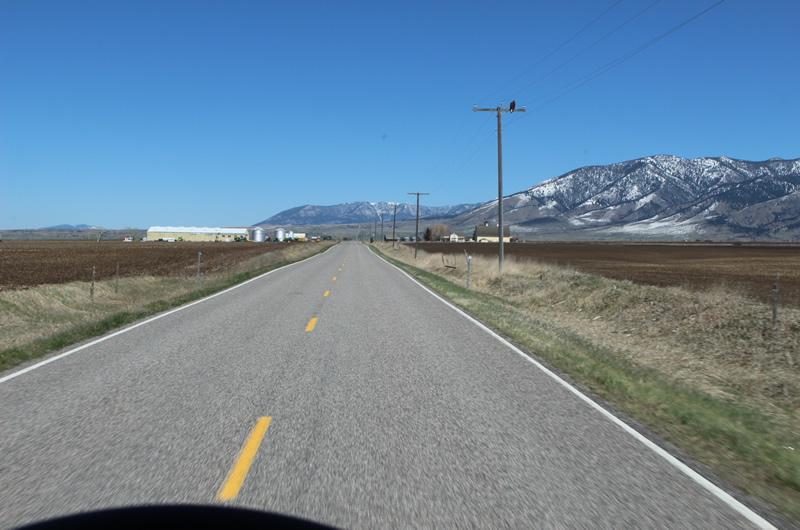
I put the pedestal in the forward position (between driver and passenger ears), and did about 1 mile going North at 60 mph recording noise levels, and then did the same stretch going South at 60 mph.
I moved the pedestal so that it was 5 ft aft of the vertical step must behind the seats, and repeated the two runs.
With the meter placed in the forward position, I could easily read it while driving along and do an eyeball average, but with the pedestal in the back, the only readings are from the phone which was set to log readings (plots below).
First Run: Meters In Forward Position, Driving North, 60 mph
This shows the noise plot from the phone running Noise Meter 2.1. Left axis is db.
The noise spikes near start and end are me yelling at meter to signify start and end. The first and last parts are getting up to 60 and decelerating at end. The middle part is steady at 60 mph, fan off, radio off, windows closed, wind near calm.
The average reading on the actual noise meter (by eyeball) was 71.
The average reading on the plot above is about 73 db.
So, the Smartphone phone meter reads about 2 db higher than the actual meter — pretty good.
Second Run: Meters Forward, Driving South, 60 mph
Right after finishing above, turned around and drove back over the same section of road North to South.
Reading on actual meter was the same — 71 db so, no difference between the North and South runs — might have been different if there had been wind.
Did not get a good recording from the phone, so no plot for this one.
Third Run: Meters Aft, Driving North, 60 mph
Moved the meter pedestal 5 ft back so that it was in the center of the cargo area, and drove the same section of highway South to North.
It looks like the the average noise level for the 60 mph part is 72 db — down about 1 db from the forward microphone position, but not much difference.
Fourth Run: Meters Aft, Driving South, 60 mph
Turned around after run just above and drove the same section of highway North to South at 60 mph.
It looks like the the average noise level for the 60 mph part is 72 db — same as the North to South run.
Observations
The tests seemed consistent and repeatable.
Its hard to tell what the absolute accuracy is in that I have no way of checking the accuracy of the noise meter, but the claim on the meter is that it is good to +- 3 db.
At first when I measured the 71 db I thought that this seemed like a pretty high noise level, and wondered about the accuracy of the meter, but this article says 70 db is typical inside a car at 60 mph.
For these 60 mph tests, just listening with ears it sounded like most of the noise was wind noise. Slowing down to 40 mph or so, the tire and engine noise become more noticeable.
While I find the noise level in our PM OK (you can talk and listen to the radio), its always nice to be quieter. There are a number of areas on my PM conversion that are not treated in any way — e.g. the sliding door is just bare metal. There are also lots of hard surfaces up in the cab area that could be softened. I will probably have a go at addressing some of these and seeing if we can drop the noise level a bit.
Some Additional Data
I took a few more measurements, including:
- Noise on other roads including gravel
- Noise with PM stopped, at idle, with no fan, half fan, and full fan.
- Noise measurements on test stretch of highway with our Honda Pilot
Effect of Fan and Engine Idle
The readings just below are from the actual noise meter with the PM stopped at side of road.
| Condition | Noise Level |
|---|---|
| Engine off, Fan off, Radio off | 40 db |
| Engine at idle, Fan off, Radio off | 48 db |
| Engine at idle, Fan 1/2, Radio off | 55 db |
| Engine at idle, Fan full on, Radio off | 65 db |
So, the fan full on with engine idling is only 5db under the level of driving at 60 mph with fan off.
Gravel Roads
Gravel road to our house at 25 to 30 mph — 68 to 74 db — more variable than paved roads.
Sypes Canyon Rd
Sypes is a paved somewhat twisty road — not in quite as good a shape as the test section — 35 mph, 68 db
Honda Pilot Noise Levels
Just for reference, I measured the noise levels in our 2004 Honda Pilot — its a fairly quiet SUV:
On the standard test section of road at 60 mph — noise level 68 db — so, 3 db quieter than our PM conversion.
On the gravel road to our house, noise level was about the same as for the PM.
The noise references say that 3 db is as small a change as the human ear can just barely detect, and this agrees with my perceptions — it seems to me the Pilot and the PM van are about equally noisy to ride in.
Simplified Test
Given the results above and just having used the noise meters a bit more, I think that you could get very similar results with a less involved test. The simple version would:
- Forgo the measurements in the back part of the van. Normally no one will be back there when driving anyway and the noise levels turned out to be very close to the ones measured up by the drivers ears.
- Just hand hold the noise meter/phone about midway between the driver and passengers ears. I took all the measurements for the Honda Pilot this way, and it seems to work fine — the noise levels do not change much if the meters moves and inch two either way.
I would stick with the other parts of the test. That is, use the same stretch of highway for all measurements, drive at 60 mph, turn the fan and radio (and any other internal noise makers) off, and observe the readings over about a mile of driving to get a good average.
I do think there there would be some benefit in buying the same sound meter I used as this is likely to give more consistent results.
I think that the key to getting results that are useful is to measure the noise levels before and after the conversion on the same stretch of highway at the same speed and with the same noise meter, and to look at the reduction in noise level from before to after conversion rather than the absolute noise levels.
Update
September 8, 2015: With a few trips under our belt, we have come to feel that the noise level in the van is a bit higher than we would like, and we plan to add some additional noise treatment. Will start with some of the untreated areas (like the sliding door), and maybe see about more noise treatment under the headliner. If I were starting the conversion over again, I’d probably pay more attention to getting more noise treatment in.

